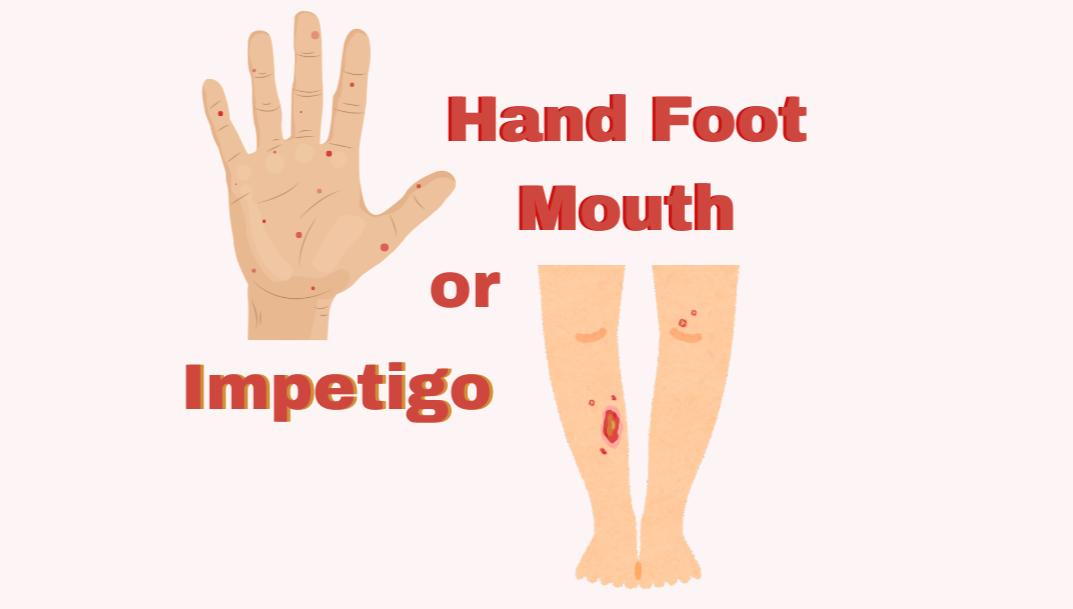HFM & Impetigo

- posted: Aug. 09, 2024
Now that school is back in session you may notice that your child developed a rash that was not there when they left the house this morning. According to the CDC, Hand Foot Mouth (HFM) disease is the most common infection among school-aged children worldwide. It can appear as red sores in and around the mouth, palms of the hand, and soles of the feet that could be painful or itchy. In some cases, the rash could also be apparent throughout your child’s body including their abdomen, arms, or legs. HFM is typically accompanied with a fever, decreased appetite, and sore throat due to pain and discomfort from the sores. This rash is very contagious and easily spread through direct contact and contaminated surfaces. The incubation period or the period between exposure to the onset of symptoms ranges from 3-6 days. The illness could last anywhere from 7-10 days and typically resolves on its own. Limiting contact with others by keeping your child home from school or away from other children in the household to minimize the spread to others. The best course of treatment would be to keep your child comfortable with Tylenol or ibuprofen. It is important to ensure your child is staying hydrated, avoid citrus or salty foods that could cause further irritation. We recommend that your child can return to school once they are fever free and have resolving lesions.
Another common skin disease is called impetigo. It is caused when naturally occurring bacteria called Staphylococcus aureus or Streptococcus aureus enter the skin through a cut, scratch, or insect bite. It can appear as a rash similar to HFM as red blister-like sores located around the face, arms, and legs. One distinct characteristic of impetigo is the honey-colored crust around the sores. It can be uncomfortable causing children to scratch the area which can allow for the sores to spread and increase the risk of a secondary infection. Similar to HFM, impetigo is very contagious and spread through direct contact. Unlike HFM, impetigo does not go away without treatment and requires oral and topical antibiotics. Children are able to return to school after 24 hours of taking the oral antibiotic and applying the topical ointment. It is important that children finish the full course of the antibiotic. In both instances always remember to practice good hygiene by disinfecting common areas and frequent hand washing to minimize the spread of infection.
If you suspect your child has HFM, impetigo, or another type of rash, give our office a call or send us a text with your child’s name and date of birth at 844-904-7384 to request a secure link to send a photo of the rash. It is important to minimize the spread of infection.
Sources:

- posted: Aug. 09, 2024
Now that school is back in session you may notice that your child developed a rash that was not there when they left the house this morning. According to the CDC, Hand Foot Mouth (HFM) disease is the most common infection among school-aged children worldwide. It can appear as red sores in and around the mouth, palms of the hand, and soles of the feet that could be painful or itchy. In some cases, the rash could also be apparent throughout your child’s body including their abdomen, arms, or legs. HFM is typically accompanied with a fever, decreased appetite, and sore throat due to pain and discomfort from the sores. This rash is very contagious and easily spread through direct contact and contaminated surfaces. The incubation period or the period between exposure to the onset of symptoms ranges from 3-6 days. The illness could last anywhere from 7-10 days and typically resolves on its own. Limiting contact with others by keeping your child home from school or away from other children in the household to minimize the spread to others. The best course of treatment would be to keep your child comfortable with Tylenol or ibuprofen. It is important to ensure your child is staying hydrated, avoid citrus or salty foods that could cause further irritation. We recommend that your child can return to school once they are fever free and have resolving lesions.
Another common skin disease is called impetigo. It is caused when naturally occurring bacteria called Staphylococcus aureus or Streptococcus aureus enter the skin through a cut, scratch, or insect bite. It can appear as a rash similar to HFM as red blister-like sores located around the face, arms, and legs. One distinct characteristic of impetigo is the honey-colored crust around the sores. It can be uncomfortable causing children to scratch the area which can allow for the sores to spread and increase the risk of a secondary infection. Similar to HFM, impetigo is very contagious and spread through direct contact. Unlike HFM, impetigo does not go away without treatment and requires oral and topical antibiotics. Children are able to return to school after 24 hours of taking the oral antibiotic and applying the topical ointment. It is important that children finish the full course of the antibiotic. In both instances always remember to practice good hygiene by disinfecting common areas and frequent hand washing to minimize the spread of infection.
If you suspect your child has HFM, impetigo, or another type of rash, give our office a call or send us a text with your child’s name and date of birth at 844-904-7384 to request a secure link to send a photo of the rash. It is important to minimize the spread of infection.
Sources:
Monday
8:00 am - 12:00 pm
1:15 pm - 5:00 pm
Tuesday
8:00 am - 12:00 pm
1:15 pm - 5:00 pm
Wednesday
8:00 am - 12:00 pm
Thursday
8:00 am - 12:00 pm
1:15 pm - 5:00 pm
Friday
8:00 am - 12:00 pm
1:15 pm - 5:00 pm
Saturday
Closed
Sunday
Closed